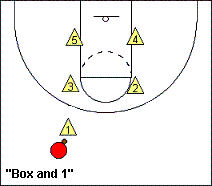Zone defense is a type of defense used in team sports, which is the alternative to man-to-man defense; instead of each player guarding a corresponding player on the other team, each defensive player is given an area, or a "zone", to cover.
A zone defense can be used in virtually all sports where a defending team is present.
Frank Lindley, Newton, KS High School basketball coach from 1914 to 1945, was among the first to use the zone defense and other innovations in the game and authored numerous books about basketball. He finished his career with a record of 594–118 and guided the Railroaders to ten state titles and seven second-place finishes.
When a team plays a zone, the defenders must keep their hands up and in passing lanes and quickly adjust their positions as the ball and the offensive players move around. Teams that successfully play zone defenses are very vocal and effectively communicate where they, the ball, and their opponents are or will be.
Teams playing a zone occasionally try to "trap" the ball handler, an aggressive strategy designed to "double-team" the player with the ball. While this tactic may cause a turnover, it leaves one or more players on the offense undefended.
Zone defenses were prohibited in the National Basketball Association prior to the 2001–2002 season. The NBA currently permits the use of zones; however, teams generally do not use them as a primary defensive strategy and no zone defense may feature an unguarded defender inside the free-throw lane (a violation of that results in a defensive three-second violation, which is a technical foul). Zone defenses are more common in international, college, and youth competition.
Types of Zone Defense

The 2–3 Zone Defense is a defensive strategy used in basketball as an alternative to man-to-man defense. It is referred to as the 2–3 because of its formation on the court, which consists of two players at the front of the defense (and closer to half court) and three players behind (and closer to the team's basket).

Match-up zone, a hybrid of man-to-man defense and zone defense where players apply man-to-man defense to whichever opposing player enters their area. John Chaney, former head coach of Temple University, is this defense's most famous proponent.

Box-and-one in which four defenders are in a 2–2 zone and one defender guards a specific player on the offense. A variant of this is the triangle-and-two, in which three defenders are in a 2–1 zone and two defenders guard two specific offensive players. This scheme was invented by the late National Basketball Hall of Fame coach and former Temple University head coach Harry Litwack.

1–3–1 Half Court Trap where a quicker but long-limbed forward guards the ball handler and attempts to disrupt quick passes as the guards have to pass around the wingspan of the larger forward. The center stands around the free throw line with a guard protecting the low post. The other two players stand on either side of the center with all 3 players keeping their arms stretched out. From many aspects this works more like a man-to-man defense, as players wear down quicker and it is tough to shoot from the perimeter over a tall forward. This zone requires a single player to be the ball defender.
Source: Wikipedia






